Abstract
Hypoxic cells in KHT sarcomas were characterized using fluorescence activated cell sorting based on the diffusion properties of the fluorochrome Hoechst 33342. Tumour-bearing female C3H/HeJ mice were injected i.v. with 10 micrograms g-1 Hoechst 33342 and the cells derived from the tumours sorted on the basis of their staining intensities. For each sorted fraction the DNA histogram was evaluated using FCM analysis. The results indicated that the bright and dim cells were not equally distributed about the cell cycle. For example, a greater proportion of S phase cells were in the bright subpopulations whereas the dim subpopulations contained an increased proportion of cells in G1. When the tumours were irradiated with a single dose of radiation prior to cell sorting, the dim cells survived preferentially. Dose response curves for the 20% most dim and 20% most bright cells, sorted on the basis of fluorescence intensity, then were determined. The survival curves of the dim and bright cells were found to have slopes similar to those of KHT cells irradiated in situ in dead animals or in vitro under fully oxic conditions, respectively. In addition, when KHT sarcoma-bearing mice were given a 2.5 mmol kg-1 dose of misonidazole (MISO) prior to irradiation and cell sorting, the dim subpopulation was sensitized whereas the bright subpopulation was not. These findings suggest that (i) compared to well-oxygenated areas, hypoxic regions of KHT tumours contain a smaller percentage of cells actively proliferating and (ii) Hoechst 33342 sorting may allow the detailed in situ evaluation of agents acting directly against hypoxic cells in solid tumours.
Full text
PDF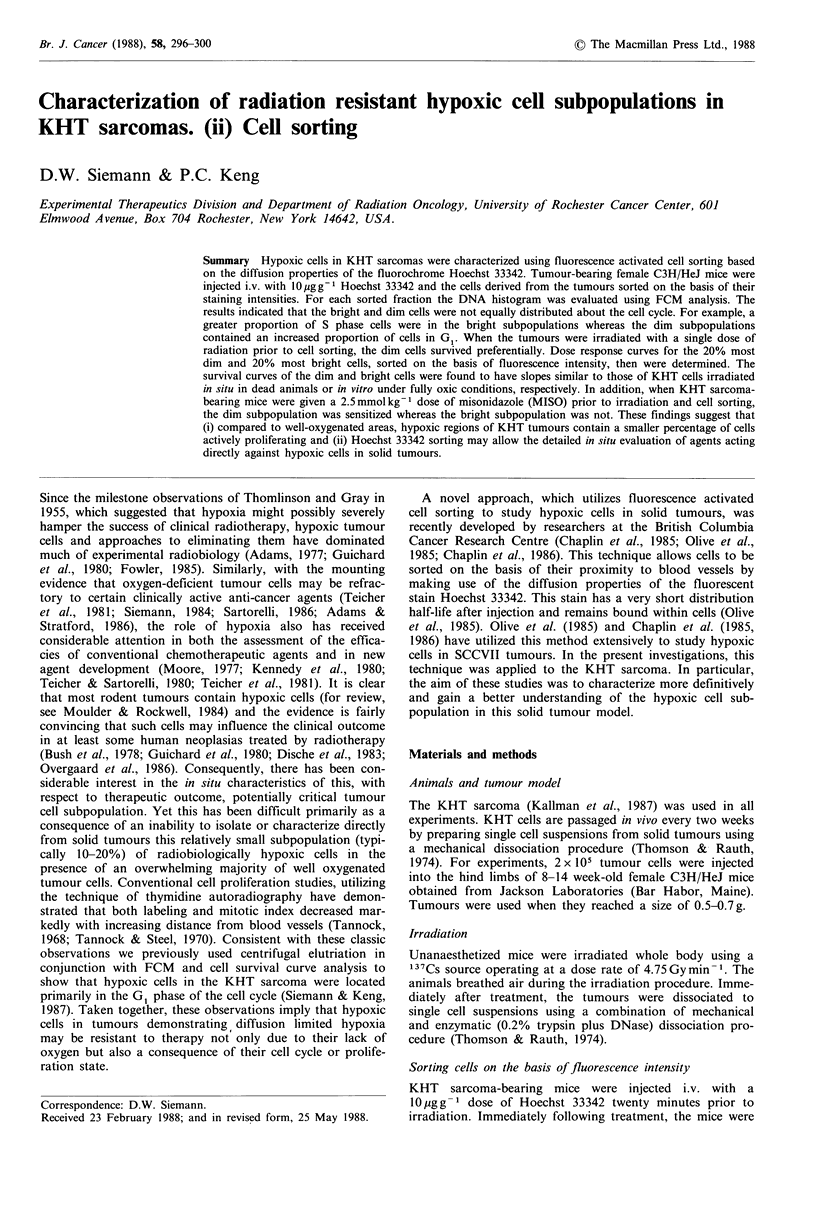
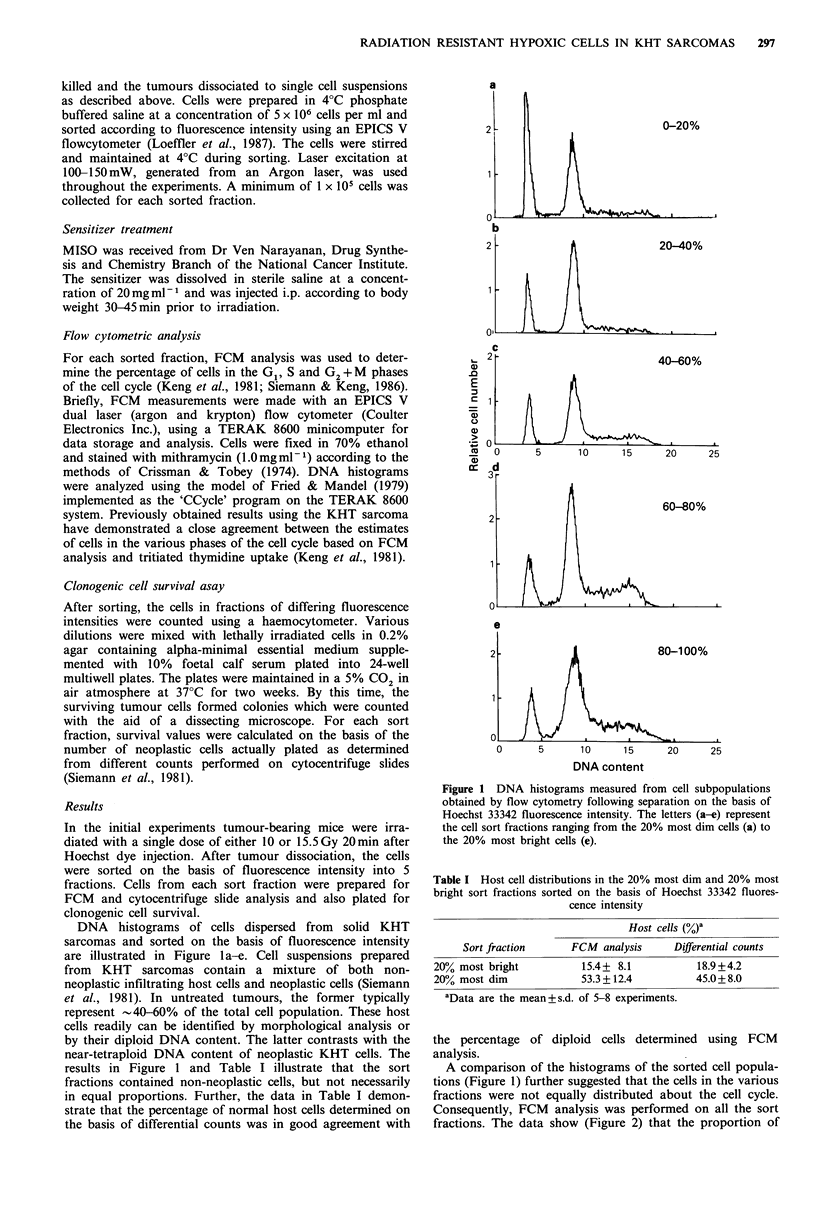
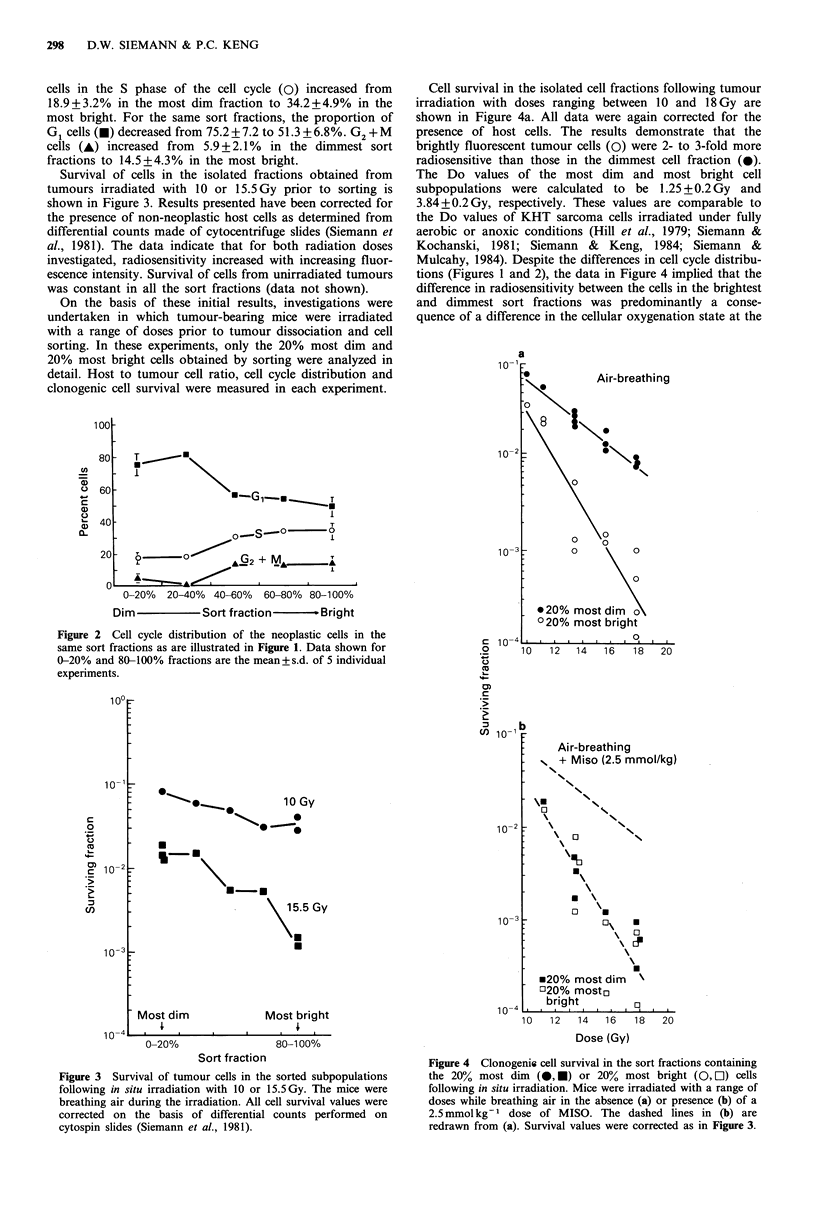
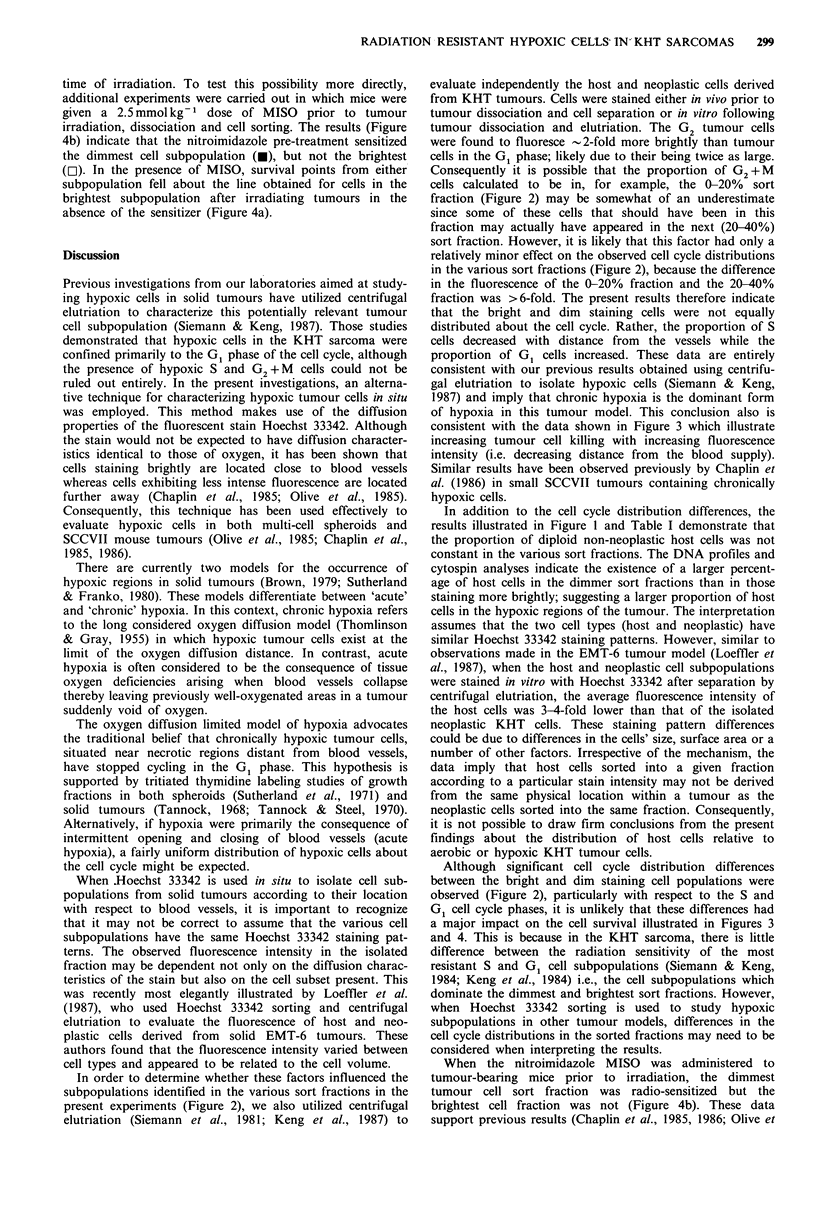
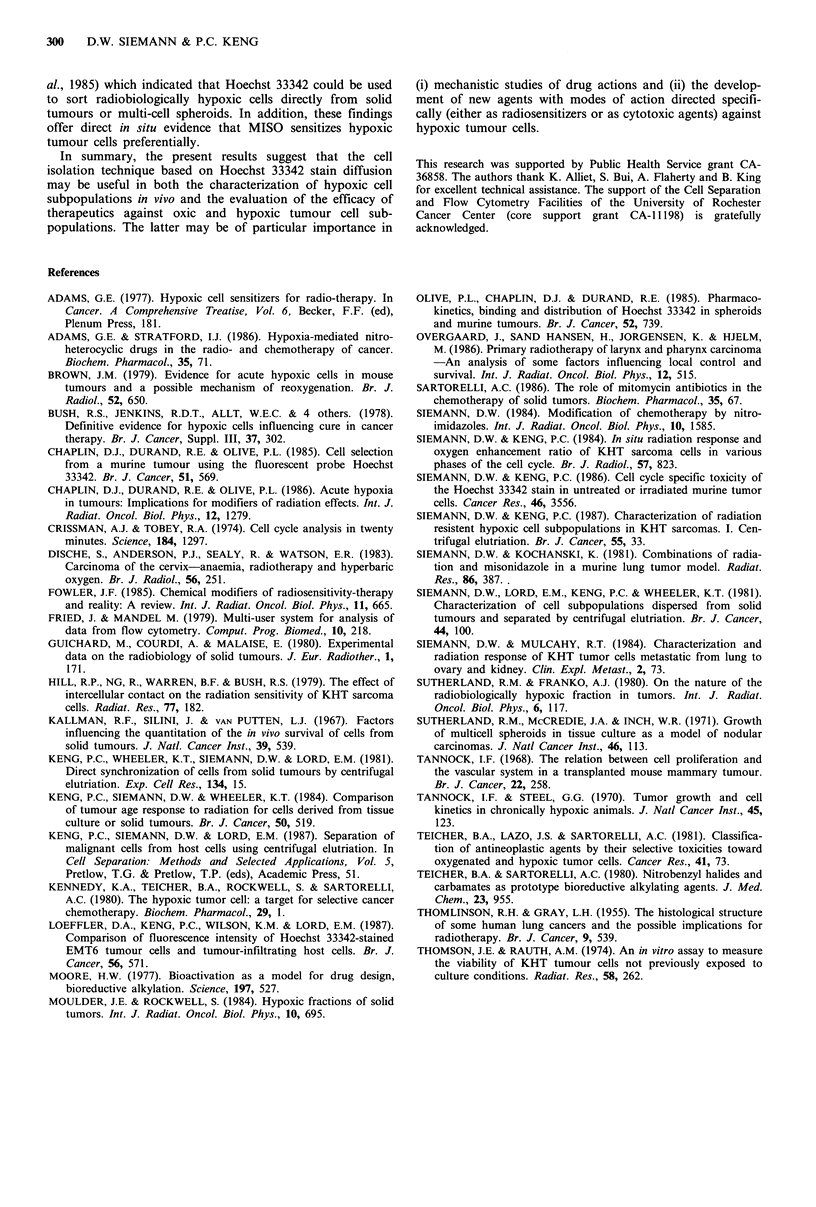
Selected References
These references are in PubMed. This may not be the complete list of references from this article.
- Adams G. E., Stratford I. J. Hypoxia-mediated nitro-heterocyclic drugs in the radio- and chemotherapy of cancer. An overview. Biochem Pharmacol. 1986 Jan 1;35(1):71–76. doi: 10.1016/0006-2952(86)90560-5. [DOI] [PubMed] [Google Scholar]
- Brown J. M. Evidence for acutely hypoxic cells in mouse tumours, and a possible mechanism of reoxygenation. Br J Radiol. 1979 Aug;52(620):650–656. doi: 10.1259/0007-1285-52-620-650. [DOI] [PubMed] [Google Scholar]
- Bush R. S., Jenkin R. D., Allt W. E., Beale F. A., Bean H., Dembo A. J., Pringle J. F. Definitive evidence for hypoxic cells influencing cure in cancer therapy. Br J Cancer Suppl. 1978 Jun;3:302–306. [PMC free article] [PubMed] [Google Scholar]
- Chaplin D. J., Durand R. E., Olive P. L. Acute hypoxia in tumors: implications for modifiers of radiation effects. Int J Radiat Oncol Biol Phys. 1986 Aug;12(8):1279–1282. doi: 10.1016/0360-3016(86)90153-7. [DOI] [PubMed] [Google Scholar]
- Chaplin D. J., Durand R. E., Olive P. L. Cell selection from a murine tumour using the fluorescent probe Hoechst 33342. Br J Cancer. 1985 Apr;51(4):569–572. doi: 10.1038/bjc.1985.79. [DOI] [PMC free article] [PubMed] [Google Scholar]
- Crissman H. A., Tobey R. A. Cell-cycle analysis in 20 minutes. Science. 1974 Jun 21;184(4143):1297–1298. doi: 10.1126/science.184.4143.1297. [DOI] [PubMed] [Google Scholar]
- Dische S., Anderson P. J., Sealy R., Watson E. R. Carcinoma of the cervix--anaemia, radiotherapy and hyperbaric oxygen. Br J Radiol. 1983 Apr;56(664):251–255. doi: 10.1259/0007-1285-56-664-251. [DOI] [PubMed] [Google Scholar]
- Fowler J. F. Eighth annual Juan del Regato lecture. Chemical modifiers of radiosensitivity--theory and reality: a review. Int J Radiat Oncol Biol Phys. 1985 Apr;11(4):665–674. doi: 10.1016/0360-3016(85)90296-2. [DOI] [PubMed] [Google Scholar]
- Fried J., Mandel M. Multi-user system for analysis of data from flow cytometry. Comput Programs Biomed. 1979 Dec;10(3):218–230. doi: 10.1016/0010-468x(79)90071-0. [DOI] [PubMed] [Google Scholar]
- Hill R. P., Ng R., Warren B. F., Bush R. S. The effect of intercellular contact on the radiation sensitivity of KHT sarcoma cells. Radiat Res. 1979 Jan;77(1):182–192. [PubMed] [Google Scholar]
- Kallman R. F., Silini G., Van Putten L. M. Factors influencing the quantitative estimation of the in vivo survival of cells from solid tumors. J Natl Cancer Inst. 1967 Sep;39(3):539–549. [PubMed] [Google Scholar]
- Keng P. C., Siemann D. W., Wheeler K. T. Comparison of tumour age response to radiation for cells derived from tissue culture or solid tumours. Br J Cancer. 1984 Oct;50(4):519–526. doi: 10.1038/bjc.1984.209. [DOI] [PMC free article] [PubMed] [Google Scholar]
- Keng P. C., Wheeler K. T., Siemann D. W., Lord E. M. Direct synchronization of cells from solid tumors by centrifugal elutriation. Exp Cell Res. 1981 Jul;134(1):15–22. doi: 10.1016/0014-4827(81)90458-4. [DOI] [PubMed] [Google Scholar]
- Kennedy K. A., Teicher B. A., Rockwell S., Sartorelli A. C. The hypoxic tumor cell: a target for selective cancer chemotherapy. Biochem Pharmacol. 1980 Jan 1;29(1):1–8. doi: 10.1016/0006-2952(80)90235-x. [DOI] [PubMed] [Google Scholar]
- Loeffler D. A., Keng P. C., Wilson K. M., Lord E. M. Comparison of fluorescence intensity of Hoechst 33342-stained EMT6 tumour cells and tumour-infiltrating host cells. Br J Cancer. 1987 Nov;56(5):571–576. doi: 10.1038/bjc.1987.243. [DOI] [PMC free article] [PubMed] [Google Scholar]
- Moore H. W. Bioactivation as a model for drug design bioreductive alkylation. Science. 1977 Aug 5;197(4303):527–532. doi: 10.1126/science.877572. [DOI] [PubMed] [Google Scholar]
- Moulder J. E., Rockwell S. Hypoxic fractions of solid tumors: experimental techniques, methods of analysis, and a survey of existing data. Int J Radiat Oncol Biol Phys. 1984 May;10(5):695–712. doi: 10.1016/0360-3016(84)90301-8. [DOI] [PubMed] [Google Scholar]
- Olive P. L., Chaplin D. J., Durand R. E. Pharmacokinetics, binding and distribution of Hoechst 33342 in spheroids and murine tumours. Br J Cancer. 1985 Nov;52(5):739–746. doi: 10.1038/bjc.1985.252. [DOI] [PMC free article] [PubMed] [Google Scholar]
- Overgaard J., Hansen H. S., Jørgensen K., Hjelm Hansen M. Primary radiotherapy of larynx and pharynx carcinoma--an analysis of some factors influencing local control and survival. Int J Radiat Oncol Biol Phys. 1986 Apr;12(4):515–521. doi: 10.1016/0360-3016(86)90058-1. [DOI] [PubMed] [Google Scholar]
- Sartorelli A. C. The role of mitomycin antibiotics in the chemotherapy of solid tumors. Biochem Pharmacol. 1986 Jan 1;35(1):67–69. doi: 10.1016/0006-2952(86)90559-9. [DOI] [PubMed] [Google Scholar]
- Siemann D. W., Keng P. C. Cell cycle specific toxicity of the Hoechst 33342 stain in untreated or irradiated murine tumor cells. Cancer Res. 1986 Jul;46(7):3556–3559. [PubMed] [Google Scholar]
- Siemann D. W., Keng P. C. Characterization of radiation resistant hypoxic cell subpopulations in KHT sarcomas. (I). Centrifugal elutriation. Br J Cancer. 1987 Jan;55(1):33–36. doi: 10.1038/bjc.1987.7. [DOI] [PMC free article] [PubMed] [Google Scholar]
- Siemann D. W., Keng P. C. In situ radiation response and oxygen enhancement ratio of KHT sarcoma cells in various phases of the cell cycle. Br J Radiol. 1984 Sep;57(682):823–827. doi: 10.1259/0007-1285-57-681-823. [DOI] [PubMed] [Google Scholar]
- Siemann D. W., Kochanski K. Combinations of radiation and misonidazole in a murine lung tumor model. Radiat Res. 1981 May;86(2):387–397. [PubMed] [Google Scholar]
- Siemann D. W., Lord E. M., Keng P. C., Wheeler K. T. Cell subpopulations dispersed from solid tumours and separated by centrifugal elutriation. Br J Cancer. 1981 Jul;44(1):100–108. doi: 10.1038/bjc.1981.154. [DOI] [PMC free article] [PubMed] [Google Scholar]
- Siemann D. W. Modification of chemotherapy by nitroimidazoles. Int J Radiat Oncol Biol Phys. 1984 Sep;10(9):1585–1594. doi: 10.1016/0360-3016(84)90508-x. [DOI] [PubMed] [Google Scholar]
- Siemann D. W., Mulcahy R. T. Characterization of growth and radiation response of KHT tumor cells metastatic from lung to ovary and kidney. Clin Exp Metastasis. 1984 Jan-Mar;2(1):73–81. doi: 10.1007/BF00132308. [DOI] [PubMed] [Google Scholar]
- Sutherland R. M., Franko A. J. On the nature of the radiobiologically hypoxic fraction in tumors. Int J Radiat Oncol Biol Phys. 1980 Jan;6(1):117–120. doi: 10.1016/0360-3016(80)90215-1. [DOI] [PubMed] [Google Scholar]
- Sutherland R. M., McCredie J. A., Inch W. R. Growth of multicell spheroids in tissue culture as a model of nodular carcinomas. J Natl Cancer Inst. 1971 Jan;46(1):113–120. [PubMed] [Google Scholar]
- THOMLINSON R. H., GRAY L. H. The histological structure of some human lung cancers and the possible implications for radiotherapy. Br J Cancer. 1955 Dec;9(4):539–549. doi: 10.1038/bjc.1955.55. [DOI] [PMC free article] [PubMed] [Google Scholar]
- Tannock I. F., Steel G. G. Tumor growth and cell kinetics in chronically hypoxic animals. J Natl Cancer Inst. 1970 Jul;45(1):123–133. [PubMed] [Google Scholar]
- Tannock I. F. The relation between cell proliferation and the vascular system in a transplanted mouse mammary tumour. Br J Cancer. 1968 Jun;22(2):258–273. doi: 10.1038/bjc.1968.34. [DOI] [PMC free article] [PubMed] [Google Scholar]
- Teicher B. A., Lazo J. S., Sartorelli A. C. Classification of antineoplastic agents by their selective toxicities toward oxygenated and hypoxic tumor cells. Cancer Res. 1981 Jan;41(1):73–81. [PubMed] [Google Scholar]
- Teicher B. A., Sartorelli A. C. Nitrobenzyl halides and carbamates as prototype bioreductive alkylating agents. J Med Chem. 1980 Aug;23(8):955–960. doi: 10.1021/jm00182a027. [DOI] [PubMed] [Google Scholar]
- Thomson J. E., Rauth A. M. An in vitro assay to measure the viability of KHT tumor cells not previously exposed to culture conditions. Radiat Res. 1974 May;58(2):262–276. [PubMed] [Google Scholar]


